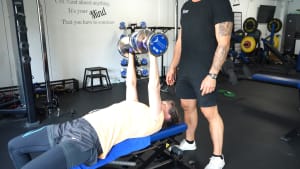
It is no stretch of the imagination to see that women who train properly can reach incredibly high levels of strength and power. Naturally, there are some important differences between male and female physiology. This may be the reason that men have a naturally higher potential for reaching greater muscle mass. For personal trainers there is a few factors to consider.
There is a speed component in weightlifting, therefore it is considered a powersport. Women’s records reach about 80% of the records held by men. The absolute world record held by women in the snatch is 160kgs and 200 kgs in the clean and jerk. Do you think very many rugby league players can equal that record? Many elite women weightlifters have cleaned and jerked almost double their body weight and many have snatched twice their body weight as well.
But how do we compare absolute strength? We would naturally assume that in a pure strength sport, like weightlifting, that men would consistently exhibit greater strength than women. But this is not exactly true.
It is true that the rules of supportive equipment change among the various federations, and there are many such federations. For example, the women’s squat and deadlift records only represent about 75% of the records held by men in the same competition. Bench pressing also shows a similar ration with women reaching 70% of their male counterparts.
Nevertheless, it is important to remember that very few women actually compete in this competition. As more women become involved in the sport, this gap could close remarkably. In terms of endurance competitions involving the upper body, women match up very well with men.
In terms of upper body muscular endurance, women’s capacities match up very well with men’s capacity. If you were to compare the number of pullups completed in one-minute, men hold a record of 52 while the record set by women is set at 39, a ratio of 75%.
I have observed that strength training programs, at least those in function In Australia, rarely include basic upper body exercises like dips and pull-ups. As a personal trainer, I see this as a very disappointing approach to the task at hand, especially if you consider all the benefits that come from this type of training.
This suggests that these personal trainers don’t fully understand the advantages of applying these routines in their strength building programs. Even though the results show that women can get strong, there are some more important differences to consider.
We will examine some of these differences that affect the design of the program.
Intensity — The Surprising Female Advantage
In my experience as a personal trainer, I have found that in many areas of athletics, women can handle a considerably higher level of intensity than men. For example, a female runner in a 800-meter competition will be able to manage repeated maximum-effort runs far better than a male runner in the same competition.
One of the most likely explanations for this is that men have a higher testosterone level which can require more fast-twitch muscle fibers. While these muscles can produce increased performance at full exertion, they will also fatigue easily.
What this means is that the considerably reduced level of muscle tension experienced by women enables them to function at a higher intensity than men. The same theory also applies to strength training.
In strength training, volume also accounts for the maximum number of reps and sets that can be performed by any athlete in a single workout. Intensity relates to the amount of weight that is lifted in comparison to the athlete’s top performance for a single repetition
For example, you may think that completing 3 sets of 10 reps is easier than completing 3 sets of 5 reps. But if the weight being lifted in those 5 reps is increased significantly, the intensity of the 3 sets of 5 reps is increased beyond the intensity of 3 sets of 10 reps.
Let’s take for example, Chinese Female Weightlifters. Here you may see that women can train at equal or even higher levels than men. Take a look at a 70kg weightlifter that can clean and jerk 70kgs. Now compare her to a male 70kg weightlifter who cleans and jerks 130kgs.
In a regular workout, the male weightlifter will lift 120kgs, which is equivalent to 90% of a single repetition or 90% 1RM. This will be done in 3 sets of 1 repetition. Because of lower muscle tension, the female weight-lifter may be able to lift 60kgs, also 90% 1RM, for a total of 6 sets of 2 reps.
Bud Charinga has taken it upon himself to study Chinese weightlifting practices and systems and has watched many of these workouts in person. In an article he wrote in 2010, Charinga discusses the warm-up protocol practiced by Chinese weightlifters.
One of the most important comparisons Charinga makes is between two Olympians that won gold. The female did 22 sets of warm-up snatches and the male did 14. Furthermore, the woman lifted the weight (120kgs) she would be practicing with 3 times in the warm up room. Next the man lifted 5 kgs than he would lift in his opening attempt and only did this once.
Charinga has written much on the subject and proposes that the female weightlifter can achieve a greater level of muscle relaxation between sets.
The ACL Problem
Both men and women are susceptible to ACL injury, but in sports like volleyball and netball, women can be as much as 8 times more likely to suffer an ACL injury as men. Many people assume this has to do with anatomical differences between men and women. Women have a wider pelvis and upper thighs that angle inward more so than a man’s making women’s knees less stable than men’s knees. But this might not be the reason.
One of the important ways to prevent injuries to the ACL includes looking into what is going on in the foot. Feet with fallen arches, a condition known as valgus, cause an internal rotation of the foot, knee, ankle and hip and this can increase the amount of strain on the ACL. This is a problem that can be compounded by wearing elevated heels, as many women do. Elevated heels will cause the knees to become hyperextended. This can also increase the stress on the ACL. If the use of these shoes were restricted only to the most special occasions, I believe that the problem with women injuring the ACL would be greatly reduced.
Conditions of fallen arches also place unnatural strain on the structural integrity of the legs and can increase the likelihood of women developing fallen arches.
Poor conditioning is another cause of ACL injuries. Not many female athletes devote as much time to strength training as male athletes do. If I were to choose the very best strength training exercise that can result in strengthening the legs and avoiding ACL injuries, I would say it is squats. But it is essential that these are performed correctly. If the squat is not done properly, if the body is not fully lowered, excessive shearing forces are placed on the knee. In other words, the forces that are attempting to pull the knee apart are increased.
Furthermore, if the athlete doesn’t lower themselves fully, the glutes and vastus medialis oblique are not fully exerted. The wide stance, high-squats used by many powerlifters do increase the effort from the abductors, but don’t do much to improve the stability of the knee.
Full squats are some of the very best exercises for improving the stability of the knee. Without the strength to control the rapid eccentric movements increases the athlete’s potential for injury. This is made evident in the fat that the vast majority of ankle and knee injuries (70%) are non-contact injuries.
Because women have such a higher propensity for this type of injury it is essential that they make eccentric training a top-priority. This is even more true in those sports that carry a high risk of knee injury.
Weightlifters that regularly practice the clean and jerk create eccentric training at high speeds, but there is very little chance that they will sustain an injury of the knees or ankles. Eccentric resistance can be increased through attaching chains to the barbells, high-end flywheels can also adjust to that speed in a fluid natural movement.
This “high-velocity eccentric overload” means that the more speed with which you pull or push in a concentric contraction, the faster the fly-wheel will push back or pull back, this results in fast eccentric training.
Cardio: at Odds with Strength
One of the considerable problems with many of the conditioning and strength training programs designed for female athletes is the right amount of energy system training. This requires abandoning the common concept of thinking of things in terms of aerobic or anaerobic exercise. Instead, we must focus on the energy systems of the body as divided into three important categories. These are short term, medium term and long term (aerobic) energy systems. Each of these will have their own set of subsections as well.
Sports in which the activities last less than 30 seconds focus primarily on the first category of short-term energy systems. Those that last between 90- 120 seconds fall into the medium-term energy systems and those that last over 120-seconds can be considered long term or aerobic energy systems. It is important to gain an understanding of these different energy systems.
These energy systems fall into a continuum, this means that they gradually shift from short-term, to medium term and then to long term. But the body doesn’t just flip off the short and medium systems after two minutes of running and engage the long-term energy systems.
Many female athletes and their coaches place an undue amount of focus on the long-term energy systems. Working the long-term energy system decreases power because it causes fast twitch muscle fibers to act more like slow-twitch fibers. If a sprinter, male or female, included 3 45-minute practice sessions of aerobic activity in their regular training, they would quickly increase their sprint times.
The effects of aerobic training are not restricted to the muscles applied in training either. For example, if you train your upper body aerobically, the muscles of the upper body will gradually become slower, but so will the muscles of the lower body. This means if you took up rowing or long-distance swimming, you may lose some inches on your vertical jump.
Aerobic training also places stress on the adrenal glands and impacts the testosterone/cortisol ratio. These are factors that increase the likelihood of gaining fat. Studies have shown that female aerobics instructors that taught for more than three hours each day had an average of 24% body fat.
So, if the athlete's sport involves both short and intermediate-term energy systems, I would recommend interval training. One of the most important advantages of interval training is that it is a great way to control and maintain body fat as well as a better way to engage the right energy system.
In summary, for personal training, women should do the biog movements and don't underestimate their recovery capability. Take in consideration the vulnerability of the ACL snd work on full ranmge squats and variations of lying and standing leg curls to help prevent injury.




